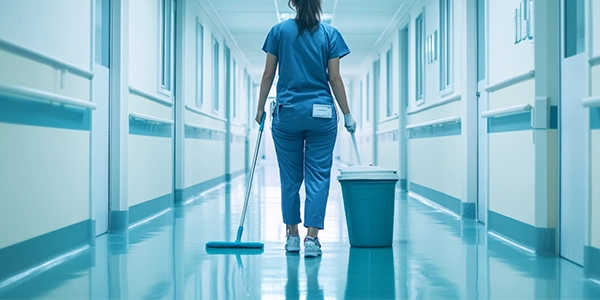Effective hospital room cleaning is essential for infection prevention and patient safety. A structured process that includes thorough cleaning, disinfection, and—where needed—sterilization helps stop the spread of bacteria and viruses while protecting patients, visitors, and healthcare staff.
Ensuring Hospital Cleanliness for Infection Control
Hospitals should follow clear, audited hygiene protocols across patient rooms, operating theatres, and high-touch areas. Focus on consistent procedures, correct contact times for disinfectants, and routine staff training.

How to Properly Clean a Hospital Room
1) General Cleaning Procedures
Use a multi-step workflow to remove soil and kill pathogens:
- Remove waste: Segregate medical and general waste; empty sharps bins per policy.
- Surface cleaning: Clean then disinfect bed rails, call buttons, tray tables, light switches, and doorknobs.
- Dusting & vacuuming: Include vents, corners, and under/behind equipment.
- Floor mopping: Use hospital-approved detergents/disinfectants; change mops per zone to avoid cross-contamination.
- Bathroom sanitation: Apply antimicrobial agents to sinks, taps, toilets, and showers with the correct contact time.
2) Disinfection & Sterilization Techniques
Select methods based on risk level and room type; verify products meet European standards (e.g., EN 14476, EN 1276, EN 13697):
- Chemical disinfection: Use EN-compliant products; follow label contact times.
- UV-C disinfection: Adjunct technology to reduce surface and airborne pathogens in unoccupied rooms.
- Hydrogen peroxide vapor (HPV): Whole-room decontamination for terminal cleaning in high-risk areas.
- Steam cleaning: High temperature for fixtures and grout without harsh chemicals.
- Electrostatic spraying: Even coverage on complex surfaces; still respect contact time.
What Is Good Housekeeping in a Hospital?
- Keep rooms uncluttered to reduce reservoirs of contamination.
- Use color-coded cloths and mops by zone to prevent cross-contamination.
- Train and audit staff on protocol adherence and hand hygiene.
- Maintain ventilation and filters; monitor humidity to deter mould growth.
What Do Hospitals Use to Clean Operating Rooms?
- Terminal cleaning: Deep clean of floors, walls, touchpoints, and equipment between cases/day end.
- Autoclaving: High-pressure steam sterilization for surgical instruments.
- High-level disinfectants: Agents such as peracetic acid for compatible devices.
- HEPA filtration & airflow: Reduce airborne contaminants during and after procedures.

Personal Hygiene Standards for Hospital Staff
- Perform hand hygiene frequently (soap and water), then alcohol-based rub as indicated.
- Wear clean workwear daily; launder at high temperatures.
- Keep nails short; avoid jewellery that can harbour microbes.
- Clean personal devices and shared equipment regularly.
Related Reading
Conclusion
A consistent, auditable cleaning regimen—paired with EN-compliant disinfectants, risk-based technologies, and strong housekeeping—creates a safer environment for patients and staff.
See CDC Infection Control guidance for additional evidence-based practices.